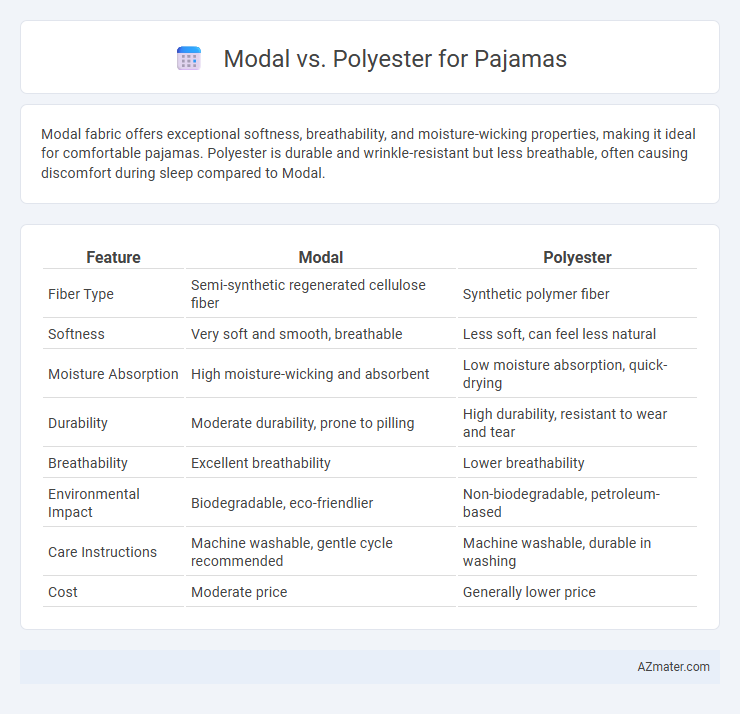Modal fabric offers exceptional softness, breathability, and moisture-wicking properties, making it ideal for comfortable pajamas. Polyester is durable and wrinkle-resistant but less breathable, often causing discomfort during sleep compared to Modal.
Table of Comparison
| Feature | Modal | Polyester |
|---|---|---|
| Fiber Type | Semi-synthetic regenerated cellulose fiber | Synthetic polymer fiber |
| Softness | Very soft and smooth, breathable | Less soft, can feel less natural |
| Moisture Absorption | High moisture-wicking and absorbent | Low moisture absorption, quick-drying |
| Durability | Moderate durability, prone to pilling | High durability, resistant to wear and tear |
| Breathability | Excellent breathability | Lower breathability |
| Environmental Impact | Biodegradable, eco-friendlier | Non-biodegradable, petroleum-based |
| Care Instructions | Machine washable, gentle cycle recommended | Machine washable, durable in washing |
| Cost | Moderate price | Generally lower price |
Introduction to Modal and Polyester Fabrics
Modal fabric, made from beech tree cellulose, is a type of semi-synthetic rayon known for its softness, breathability, and moisture-wicking properties, making it ideal for comfortable pajamas. Polyester, a synthetic polymer derived from petroleum, offers durability, wrinkle resistance, and quick-drying features, often blended with other fibers to enhance fabric performance. Both materials serve different functions in sleepwear, with modal prioritizing comfort and natural feel, while polyester provides strength and easy care.
What is Modal?
Modal is a type of semi-synthetic fabric made from beech tree cellulose, known for its exceptional softness, breathability, and moisture-wicking properties, making it ideal for pajamas. It is more absorbent than cotton and retains its shape and color after multiple washes, providing durability and comfort. Modal pajamas offer a silky feel with excellent drape, ensuring a luxurious sleep experience compared to polyester, which tends to be less breathable and synthetic-feeling.
What is Polyester?
Polyester is a synthetic fiber made from petrochemicals, known for its durability, wrinkle resistance, and quick-drying properties. It is commonly used in pajamas for its affordability and ability to retain shape after washing, making it suitable for everyday wear. Unlike natural fibers, polyester tends to trap heat and moisture, impacting breathability and comfort during sleep.
Comfort and Softness Comparison
Modal fabric offers superior softness and breathability compared to polyester, making it ideal for pajamas designed for maximum comfort. Modal's moisture-wicking properties help keep the skin dry and cool, whereas polyester tends to trap heat and moisture, potentially causing discomfort. The natural fibers in modal provide a smoother, gentler feel on the skin, while polyester's synthetic texture can feel less breathable and less comfortable for prolonged wear.
Breathability and Moisture Management
Modal fabric offers superior breathability due to its natural cellulose fibers, allowing air to circulate more freely and keeping the body cool during sleep. Polyester, a synthetic material, tends to trap heat but is engineered with moisture-wicking properties to draw sweat away from the skin, enhancing moisture management. Pajamas made from modal provide a softer, more breathable option, while polyester excels in moisture control, making each suitable for different sleep needs.
Durability and Longevity
Modal fabric boasts excellent durability due to its cellulose-based fibers, which resist pilling and retain softness even after multiple washes, ensuring long-lasting comfort in pajamas. Polyester is highly resilient, offering superior strength and resistance to shrinking, stretching, and wrinkling, making it a practical choice for pajamas that withstand frequent wear. When comparing longevity, modal maintains breathability and comfort over time, while polyester emphasizes durability and shape retention, with both materials providing extended lifespan depending on care and usage.
Environmental Impact: Modal vs Polyester
Modal fabric, derived from sustainable beechwood pulp, is biodegradable and requires less water and energy during production, significantly reducing its environmental footprint. In contrast, polyester, a synthetic fiber made from petroleum, contributes to microplastic pollution and is non-biodegradable, causing long-term environmental harm. Choosing modal pajamas supports eco-friendly practices and minimizes plastic waste compared to polyester options.
Maintenance and Care Tips
Modal pajamas require gentle machine washing in cold water to maintain their softness and prevent shrinkage, with air drying recommended to avoid fabric damage. Polyester pajamas are durable and wrinkle-resistant, allowing for machine washing with warm water and tumble drying on low, but high heat should be avoided to prevent melting or pilling. Both fabrics benefit from avoiding bleach and fabric softeners to extend garment life and preserve color vibrancy.
Price and Affordability
Modal pajamas typically cost more than polyester due to their natural fiber content and superior breathability, offering a softer and more comfortable feel. Polyester pajamas are generally more affordable and widely available, making them a budget-friendly choice for those seeking durability and easy care. Consumers prioritizing cost savings often opt for polyester, while those willing to invest in premium comfort tend to choose modal.
Which Fabric is Better for Pajamas?
Modal fabric offers exceptional softness and breathability, making it ideal for pajamas that prioritize comfort and moisture-wicking properties. Polyester, while more durable and wrinkle-resistant, tends to retain heat and lacks the natural breathability of modal, which may lead to discomfort during sleep. For pajamas, modal is generally better suited due to its lightweight feel and ability to maintain softness after multiple washes.

Infographic: Modal vs Polyester for Pajama
 azmater.com
azmater.com